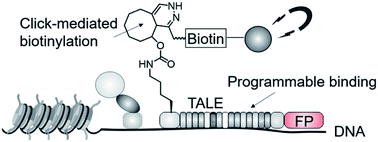Encoded, click-reactive DNA-binding domains for programmable capture of specific chromatin segments†
Abstract
Enrichment of chromatin segments from specific genomic loci of living cells is an important goal in chromatin biology, since it enables establishing local molecular compositions as the basis of locus function. A central enrichment strategy relies on the expression of DNA-binding domains that selectively interact with a local target sequence followed by fixation and isolation of the associated chromatin segment. The efficiency and selectivity of this approach critically depend on the employed enrichment tag and the strategy used for its introduction into the DNA-binding domain or close-by proteins. We here report chromatin enrichment by expressing programmable transcription-activator-like effectors (TALEs) bearing single strained alkynes or alkenes introduced via genetic code expansion. This enables in situ biotinylation at a defined TALE site via strain-promoted inverse electron demand Diels Alder cycloadditions for single-step, high affinity enrichment. By targeting human pericentromeric SATIII repeats, the origin of nuclear stress bodies, we demonstrate enrichment of SATIII DNA and SATIII-associated proteins, and identify factors enriched during heat stress.



 Please wait while we load your content...
Please wait while we load your content...